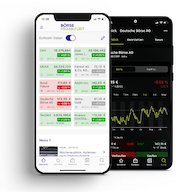Weekly outlook: Customs letter dampens mood

Hopes for a trade deal with the US have been dashed for now. Some point to valuations that are already too high. However, many see this as a good opportunity to get in on the market.
14 July 2025. FRANKFURT (Börse Frankfurt). US President Trump's plan to impose a 30 percent tariff on imports from the EU starting August 1 is weighing on the stock markets. This is because, after weeks of negotiations, an amicable agreement in the trade dispute had actually been expected. On Wednesday, the DAX had reached a new all-time high of 24,639 points, but on Monday morning it was down to 24,020 points. The Stoxx Europe 600 is also showing signs of weakness. The development of Bitcoin is striking: the most important cryptocurrency has reached a new record high. In early trading, the price climbed above the US$120,000 mark for the first time and is currently at US$122,000.
“Decisive moment in customs saga draws nearer”
The mood on the stock markets had already been subdued since Thursday – Trump had threatened the EU with blanket punitive tariffs of 15 or 20 percent. This was followed on Saturday by the concrete announcement of 30 percent from August. “There is a great deal of uncertainty, especially since trade restrictions through tariffs have a negative impact on economic growth and inflation,” notes Helaba analyst Ulrich Wortberg. "Donald Trump's letter to the EU is not a love letter, but neither is it a hate letter. It is a letter intended to increase the pressure in the ongoing negotiations,“ comments chief economist Carsten Brzeski of ING. The coming days and weeks will show whether Europe is willing and able to make compromises that suit the US. ”In any case, the letters indicate that the decisive moment in the tariff saga is drawing ever closer."
Valuations too high?
According to Sören Hettler of DZ Bank, the valuation ratios for most indices are already in the expensive range. Earnings per share expectations have not kept pace with the rise in share prices, and the P/E ratio is well above the long-term average. Other indicators such as the price-to-book ratio, dividend yield, and risk premium compared to government bonds also showed very ambitious valuations. Hettler sees increased downside risks in the short to medium term, especially for the DAX and S&P 500. “However, 2026 is likely to bring sustainably higher prices and new records.”
“Take advantage of weak phases to buy”
In view of the promising economic outlook for 2026, Andreas Hürkamp of Commerzbank recommends taking advantage of possible weaker market phases in the coming months to expand DAX positions. “However, a mixed DAX earnings season due to the strong euro and a temporary rise in US inflation caused by US import tariffs could initially slow down the DAX's record run in the seasonally weaker months of August and September,” he says.
Start of the US reporting season
Tomorrow, Tuesday, Citigroup, JP Morgan, and Wells Fargo will kick off the US reporting season for the second quarter. Bank of America, Goldman Sachs, and Morgan Stanley will follow on Wednesday. Then things will continue apace, with Johnson & Johnson and Netflix among others. According to DekaBank, the consensus for the S&P 500 is for earnings growth of around 3.5 percent – a clear slowdown after the surprisingly strong first quarter. The bank expects figures to be well above estimates, especially for S&P 500 companies. “However, investors are likely to have already anticipated some of the good news,” explains Ulrich Kater.
Important economic data
Tuesday, 15 July
4:00 a.m. China: Second quarter GDP. According to DekaBank, Chinese exporters have cushioned the impact of increased US tariffs with the help of circumvention strategies and higher sales in other markets. Nevertheless, growth has likely slowed.
11:00 a.m. Germany: ZEW economic expectations for July. According to DekaBank, ZEW economic expectations for Germany returned to their pre-Liberation Day level in July. Although the assessment of the current situation does not yet reflect this recovery, it could still rise to its highest level in two years.
2:30 p.m. USA: Consumer prices for June. Price pressure is likely to have increased further, according to Deutsche Bank. The annual overall rate is expected to rise from 2.4 to 2.6 percent, with the core rate increasing from 2.8 to 2.9 percent.
Thursday, 17 July
2:30 p.m. USA: Retail sales for June. According to Commerzbank, the figures will show that the US economy is currently going through a weaker phase due to the latent uncertainty in the trade dispute.
by: Anna-Maria Borse, 14 July 2025, © Deutsche Börse AG
About the Author
Anna-Maria Borse is a financial and business editor specializing in financial markets/stock exchanges and economic issues.
Feedback and questions to redaktion@deutsche-boerse.com





